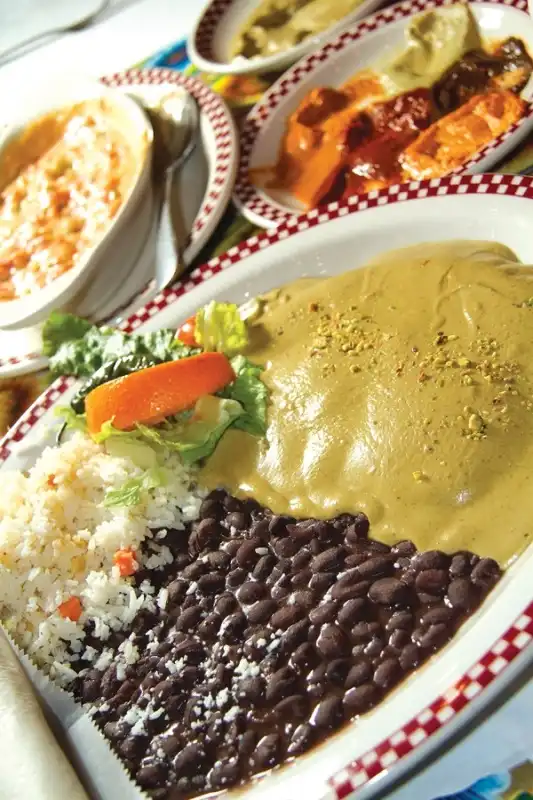Food Review: Red Iguana – April 2010
Food Reviews
Red Iguana
Mon. – Thurs. 11 AM – 10 PM
Fri. 11 AM – 11 PM
Sat. 10 AM – 11 PM
Sun. 10 AM – 9 PM
866 W. South Temple
801-214-6050
Rediguana.com
Reviewing a restaurant as famous (and deservedly so) as the Red Iguana involves a lot of backward glances and gestures towards my own sense of nostalgia. During this review, the Iguana was so busy that of eight meals, I had only one in the original North Temple location that has been open since the 80s, and the rest, at a second, brand-new location just a few blocks away.
When locals want to take their out-of-town guests to a great Salt Lake Restaurant, the place where they very often end up is the Red Iguana. One of the most famous and best-loved restaurants in town, the Iguana has, over the years, developed a local cult following and a national reputation.
When the City Weekly and Salt Lake Tribune recently did their yearly list of the best restaurants and both omitted the Red Iguana, the outpouring of protest mail was immense and heartfelt. Obviously, this legendary place has personality. Actually, a personality. The Red Iguana’s famous chef and son, Ramon Cardenas Jr., was a big, well-loved and well-feared super-man (he was like six foot three and really big, really!).
He had close friendships with many Los Angeles rock stars (Oingo Boingo, the Paladins, Los Lobos, Fishbone) who often visited the restaurant, and whose autographed photos graced the walls over the years. His larger-than-life persona and self created vibrant Tex-Mex style of dress alone would have been enough to make him stand out at any of the local events at which he was invariably spotted, but add to that the rumors that followed him and he emerges as one of Salt Lake City’s cool icons of the 1980s and 90s.
Although he is now deceased, his family’s mole is still perfection, and like the man himself, a force of nature. The Red Iguana’s story is a western. Arriving here in 1965, Ramon Cardenas Sr. and Maria Cardenas opened the traditional American/Mexican Casa Grande restaurant, and then, in 1985, The Red Iguana.
Immediately it started shaking up what people expected from Mexican food. Introducing really great Oaxaca and Puebla styled moles, they kicked in the doors that fast food Mexican had crouched behind. It was as if a stranger had come to town and set everybody free. What had been a caricature of an idea of a meal became a culture and a way of eating.
A South-Western renaissance of the mouth had arrived in Salt Lake City. I have always believed that there is no better Mexican food in this town than Red Iguana, and even when I nearly died, (my heart literally stopped), while eating a Chile Verde Burrito in 1998–my fault, not the burrito’s—I was soon back in the saddle and in my seat at this colorful home of comfort and conversation. I love love love the mole that Red Iguana serves.
Mole is the Mexican national dish—a sauce made with chocolate and chilies among many other changing ingredients. As anyone who has ever tried it knows, it is devilishly hard to make well, and takes a very long time to make properly. It is also among the supreme foods on earth (or so say I). I’ve tried to make mole from scratch on an occasion or two that ended up being pretty wide of the mark, and I’ve had mole from the bottle many times, and pre-made in plastic portions and from powder.
None of them are ever as simply powerful, dynamic and wholly formed as the Red Iguana’s. The whole event of eating at the Iguana conspires towards pleasure—the pleasure of drinking a cold beer or cold margarita or even a brisk cup of coffee while waiting to get an order in. Don’t forget the customary and always delicious chips and salsa. Really folks, its not hyperbole to say that in the first five minutes of drinks and chips, I often have as good of a time as I have in the space of an entire meal elsewhere.
All of Red Iguana’s moles are served on a small platter with rich, warm gravy smothering a piece of poultry or pork, a side of Spanish rice, refried beans and a tortilla. The Mole Negro ($14.95) is a dark, thick sauce possessed of a savory sweetness that acts as the perfect foil to the flavors of chocolate and chilies. Like wind slowly considering a bed of coals on a dark night, flavors appear and disappear, never leaving, never changing altogether, but never the same.
As with a good scotch, it stands contemplation well, as do all the moles here. The Mole Poblano ($14.95), the most famous of Mexico’s moles gets served here over turkey. Its brown warmth is dry at first, like dark chocolate, but the exuberance of the middle flavors of the chili oils and the seeds and nuts offer a set of flavors that, while unexpected, are also just plain right and rich. The Mole Amarillo ($14.95) is very spicy, flavored with habanero peppers, but without being sadistic or presumptuous like a five pepper Thai dish can be.
But it is pretty gringo hot. I like to get the Negro and Amarillo on the same plate, a request for which I have never received a second look. I know that there are many vegetarians and vegans who are good SLUG readers, and these moles sound, and are, so good. But, they simply are not vegetarian, a lot of the menu is not—sorry, folks. However, along with a few basic choices for the vegetarian, there are also a few outstanding ones.
Not much for the vegan, though, where there is no meat there is usually cheese and cream. One of the biggest sellers here, the Chicken Chimichanga ($8.25), didn’t really hit my radar, though one of my fine servers said it was one of the biggest sellers and excellent. The Vegetarian Chimichanga ($8.05), however, got ordered twice by my main squeeze who is veg, and it was quite delicious with a bright red sauce, chunks of tasty potato and stewed vegetables in a fried burrito dolloped with sour cream.
I would have been happy with it. She was. Also fair game for the vegetarian are the very tasty and rich Enchiladas Poblanas ($8.35), cream cheese enchiladas topped with traditional enchilada sauce, cheese, and sour cream which in my notes I called “a pushover, but makes you want a second bite.” Of course the Bean Burrito is vegetarian, but to be perfectly honest, the one we ordered was not so great—not as great as I wanted it to be, at least.
This came as a bit of a surprise, but the 24-hour Mexi-drive-thru has really got these down and our teen-aged vegetarian diner was unimpressed. When these failed to please, the waitress pointed us to the Enchiladas Potosinas ($8.70), a set of four empanada shaped masa shells filled with cheese, onions and chilies. These were pretty daring in their desert solitude of flavors. They ate fine and were enjoyed, but they ask of the mouth some patience and imagination.
I was surprised with how totally enjoyable and sensually satisfying I found the Pollo A La Moreliana ($13.40) which is one half of a good sized chicken marinated in white wine and spices, browned, then simmered with tomatos, onions, chilies, potatoes, carrots and zucchini. Damn. Tender and really delicious, it eats in morsels with a vegetable-flecked broken rice and vegetables on a warm tortilla.
It’s one of the favorites of local tattoo celebrity C.J. Starkey, and I wouldn’t have thought to try it without his mention. Thanks. Among the things that are just as good as everyone says are the Tacos Don Ramon ($24.95), served as a small plate of three tacos filled with shredded, fragrantly spiced beef. They are mild and slightly cinnamon flavored and make the hot and greasy carne asada one finds in the ubiquitous street tacos, which at first seemed so great, feel pretty coarse in comparison to these little darlings.
The combination plates that are served here are probably the best fallback position for the undecided. I can’t say that any of them is better than the next, but the Red Iguana Platter ($13.50) is awfully good with its mixture of a chile relleno, a cheese enchilada, a shredded beef taquito, a beef flauta covered with guacamole and sour cream, and a beef tostada. Woof.
I distrust the diners who get combination plates at Asian restaurants—none of the good things ever end up there, just the homogenized, de-dangerized bleached boredom of an idea of a cuisine. But with the Red Iguana platters you get a who’s who of the menu, and with few exceptions, it’s a pretty great tour. The Mexican Plate ($12.65) is my favorite of these combos, which includes, among it’s various other offerings of subtle pleasure and taste, the deadly good Chili Verde burrito.
I usually don’t end most meals with sweets, but the desserts at Red Iguana are actually quite good, and while some are dainty, some are surprisingly large. An order of the Sopapillas ($4.95) will feed lots, maybe even ten with little servings of sweet, crisp fun. These little flowers of fried dough sweetened with syrup and sprinkled with cinnamon and sugar are much more subtle and adult than the variety I grew up with at the mexi-fast-food corner store.
The excellent Flan ($5.25), which is a traditional custard pie, served with two great dollops of whipped cream and two cherries, is buttery sweet goodness. The Fried Ice Cream ($5.25) includes shredded coconut, cinnamon, and sugar, all wedged into a tortilla, artfully folded into a claw and deep fried, and is also piled high with whipped cream. Sweet.
Like siblings, the two locations share a family identity, but the new restaurant is still finding its collection of history for the walls, and its tables are still shiny. The new location has the same menu and officially the same food, but I wonder how it will evolve to become it’s own chapter in the legend.
And, with a third Red Iguana now open in the downtown City Creek food court, one fears the mainstreaming of this rich and rowdy local treasure. How this new century will treat Salt Lake might be written small in the story of the Red Iguana. If that is the case, will we grow up, change, and with the inevitable losses that accompany it, will our little piece of the West become more civilized?


